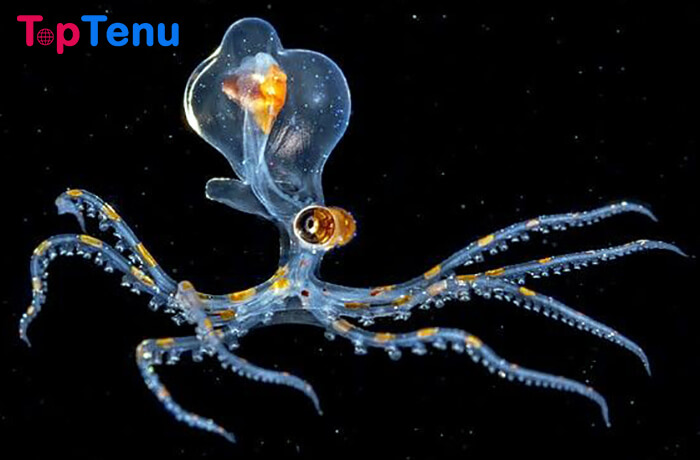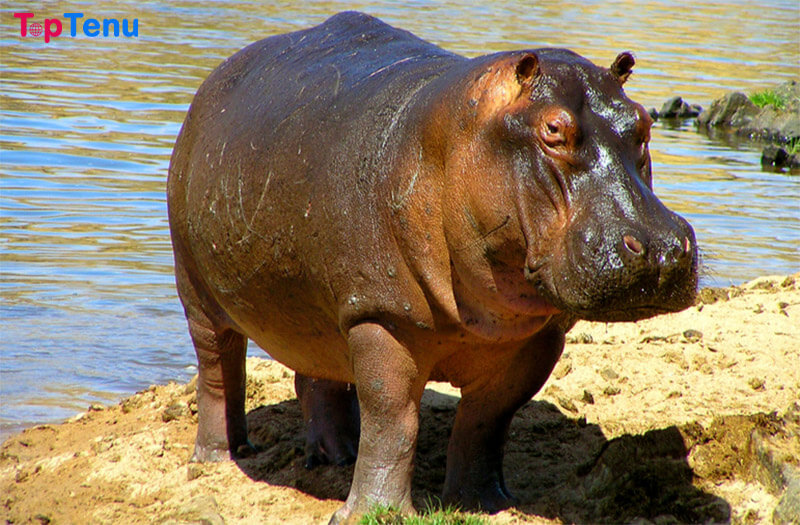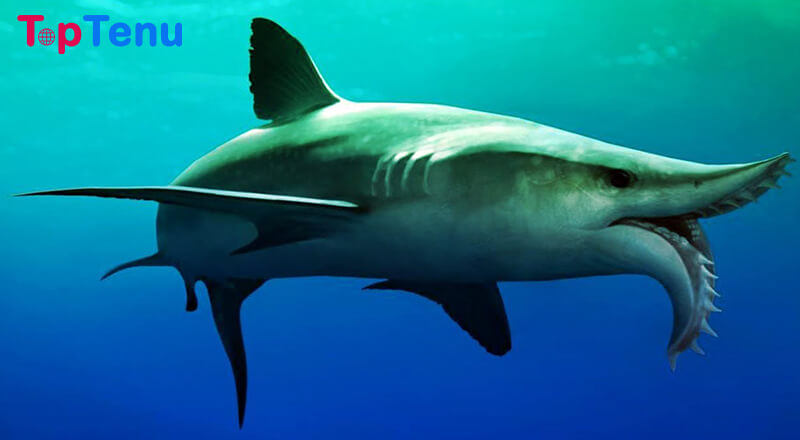Who’s your companion on the journey of world discovery. If you have a pet like a cat or dog, you may have seen how they reproduce.
It’s not surprised that mammals can give birth easily but not all of them reproduce in the same way.
There are creatures on Earth that have such a strange way of reproducing, which will surprise you.
Let’s get to animals with amazing and bizarre reproduction The number one will amaze you.
10: Surinam Toad
Normally, animals give birth or lay eggs, but this toad is different. Baby toads born from mom’s back. How do they can do such an unthinkable thing?
Surinam Toad is the aquatic animal in South America. The toad has a leaf-like flat body with the length of 10-20 cm. When the season of rain starts, this species will make the mating call.
Can you imagine? Males and female toads can mate with each other for up to 24 hours. Then, Surinam male toad will then carry the fertilized egg to a honeycomb shaped part on the female’s back.
Miraculously, the skin of the female toad’s nest heals itself to cover the eggs, which helps protect the eggs until they hatch in the next four months.
Here, the eggs will hatch into tadpoles, after falling off the toads, the baby will jump off from their mom’s back.
Then the honeycomb shaped part on the back of the mother toad will fall down to prepare a new cycle.
What is special about Surinam toad is that the baby toads have all parts after hatching, not just tadpoles like other kinds of toads,
9: Darwin’s frog
It’s weird enough when Cichlids hold the fry in their mouths. Darwin’s frogs are even weirder when they swallow their eggs into the stomach.
The female frogs will lay its eggs as usual but it does not have the duty to incubate. In contrast, the males will swallow their eggs into the abdomen, incubating for at least 6 weeks, the eggs will hatch into tadpoles.
The males will then vomit them out through their mouths. When these frogs swallow eggs in their bellies, their stomachs will temporarily stop producing acid so that eggs will not be destroyed as food.
When they incubate, they do not go out to forage. The reason for this is because the process of turning an egg into a tadpole then a grown-up frog is very tough.
The eggs can be eaten, broken; tadpoles are hunted; the babies might eat each other, and even a grown-up frog will get weak.
In order to reduce the risks of female growth, the father frog sacrificed to carry the eggs in his body, the tadpoles grow right inside his father’s pouch, where’s safe and comfortable, but the male frog is probably not comfortable at all.
8: Kangoroo
A kangaroo can become pregnant and temporarily build its reproductive process. It sounds strange, but it is the truth.
If a kangaroo isn’t ready to give birth, like taking care of another baby, then the embryo will stop growing after a few days until it really wants to give birth.
Female kangaroos have 3 separate vaginal tubes and 2 wombs, allowing them to feed up to 3 babies at a time in different stages.
Kangaroo’s pregnancy is one of the strangest things in the animal world that is equivalent to 7 weeks of pregnancy in the human body.
The offspring begin to appear, they use all their strength to cling to the thick fur and then slip into the bag before the womb for their safety.
When a kangaroo baby enters the mother’s pouch, it sucks only one nipple at the 34th weeks of age. Until when it gets older that it begins to change to the other nipples.
Sometimes the kangaroo babies can’t suck the milk themselves that makes the mothers suckle them. Some young Kangaroos won’t leave the warm pouch for 8 months. They now have full of cilia and can bounce around their mothers.
7: Seahorse
Seahorses usually live in tropical waters with a length of 16-35cm. They can be considered a species of fish because they have full pectoral and dorsal fins.
Seahorses are closely related to Syngnathiformes and Sargassum fish because of its characteristic. Males often carry eggs and give birth in lieu of the female’s duty.
However, instead of being pregnant in the abdomen like the female, the male seahorse will put the eggs in a pouch, just like kangaroos.
The female will put her eggs in the male’s pouches and then continue to make eggs. A male seahorse can give birth to the next litter within the same day if the female has accumulated enough eggs.
Thanks to this assignment, the female has time to recover to produce more eggs instead of taking on both duties.
Before putting the eggs in the bags of the male seahorse, the female has infused the nutrition into the eggshell.
After getting the eggs into the pouch, the male seahorse will add their sperm and shut the opening, creating an environment for the eggs to develop.
The duration of pregnancy of the seahorse is from 2 to 3 weeks, after about 20 days the baby seahorse will grow eyes, snout, and tail.
This time, male seahorses will have to be extremely careful before the enemy. After enough time, the male seahorse will get its babies shot out of the opening.
And there’re up to 1000 baby seahorses leave their dad’s pouch and float off into the wild. Baby seahorses can feed themselves without the help of their parents. How amazing!
6: Sea urchins
Sea urchin fertility is extremely amazing. For example, a female sea urchin can produce 20 million eggs during the breeding season.
They emit something like a cloud containing male and female eggs. Of course, many other creatures immediately sought to eat those eggs, but there are still many floating eggs found in the ocean.
In a few hours, they can turn into small furry balls covered in feathers. And the sea urchin eggs can drift for months on the stream and eat algae along their way to grow.
During this time a tiny sea urchin grows inside the egg. Till the right time, they will choose a place to stop and develop its own journey.
5: Slugs
Not everyone knows that a slug has both male and female genitalia, so any female can get pregnant on her own after mating.
Although there are both male and female genitalia, the slug cannot fertilize itself. Before mating, the slug shoots the “love darts” to the partner’s womb.
The mucus from the arrow helps the uterus of the slug hold more eggs, which increases fertility. When mating, the two slugs come close to each other, the two reproductive organs cross-fertilize each other.
As a result, both of them get pregnant. After 10-30 days depending on the species, the baby slug hatches and eat the unhatched eggs nearby.
4: Bees
After being mated with male bees, the queen will lay eggs in each hole of the hive. Worker bees will take care of hatched eggs and raise larvae until they grow up.
For example, the queen takes 15 days to develop from an egg to a young queen. In which, there’re 2 days for the larvae to hatch from eggs, 5.5 days to develop into pupae, and 6.5 days later to become young queen bees.
Male bees need 22.5 days to grow from eggs to young males. 3.5 days for larvae to hatch from eggs, 6.5 days to develop into nymphs and 13 days for pupae turn into bees.
The worker bees take 21 days to develop from an egg to a young worker, the journey is divided into 3, 6.5 and 12 days.
Queen bee larvae are fed entirely with royal jelly, male bee larvae and worker bee larvae are reared for the first 3 days with milk, and after 3.5 days later, they’re fed with a mixture of pollen and honey.
3: Cichlids
Cichlids live in large lakes in Africa. This fish has many interesting things, but the most interesting is probably that they raise the fry in the mouth rather than in the belly like other fish.
This makes it easier for Cichlids to protect their fry from underwater enemies. Thus, Cichlids sometimes not only hold eggs but also place the fry in their mouths.
The probability of survival of the fry gets higher. This method is also found in some other fish or amphibians, usually the male will take charge of this egg.
2: Centipedes
The centipedes with multi-legs look so scary. The centipede’s fertility is amazing. They are parthenogenetic that means there is no need for direct mating between males and females.
Basically, the male centipedes drop their semen so that the female will automatically pick them up. The reproduction cycle of centipedes is not seasonal.
In fact, not many centipedes do this, most will abandon the eggs and let them grow on their own. Only the red-headed centipede shown in the will take care of their babies until the slough for 1or 2 times.
By covering the babies with their bodies, the mother wants to protect them from natural enemies such as toads, clones, and mice.
However, if they are in danger during incubation, the mother centipede is ready to eat all the eggs instead of letting the outsiders have them.
1: Octopus
Octopus is a species that spawns. They have a very strange reproductive process. During sexual intercourse, males use tentacles to introduce sperm into the female.
The female octopus can hold sperm in her body until the egg is ready for fertilization. The average number of eggs is about 200,000.
The mother will then protect and provide oxygen to the eggs by blowing water through. However, this process of reproduction of octopus has a scary secret.
After laying eggs, they starve themselves and die at the time of hatching. Their mates also share the same fate. They are attacked and eaten by the female octopus.
In captivity, this process is even faster. Some female octopus also tear or gnaw themselves.
Scientists think this could be a rather interesting evolutionary mechanism, preventing the octopus themselves to eat their offspring because it is one of the same species of hunting behavior.
What animal is the strangest to you? Whether I forget any kind? I hope it’ll be helpful to you guys.




